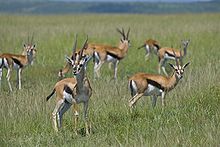Thomson's gazelle
Thomson's gazelles are two species of gazelle that are found in the East African countries of Kenya and Tanzania. Until the beginning of the 21st century, these were still considered a single species and were listed under the scientific name Eudorcas thomsonii (formerly Gazella thomsonii). A revision of the hornbearers published by Colin Peter Groves and Peter Grubb in 2011 split the eastern from the western population. The following species are now distinguished:
- Western Thomson's gazelle (Eudorcas nasalis (Lönnberg, 1908)); in Tanzania and in Kenya in the Serengeti ecosystem west of the East African Rift;
- Eastern Thomson's gazelle (Eudorcas thomsonii (Günther, 1884)); in Kenya and Tanzania east of the East African Rift, roughly from the Nairobi and Kilimanjaro regions through Arusha, the Wembere plains to Shinyanga;
The Thomson's gazelle is named after the Scottish African explorer Joseph Thomson, who brought a set of horns from eastern Africa to the first describer of the Eastern Thomson's gazelle, Albert Günther. West of the Thomson's gazelle, in southern Sudan, a similar form, the Mongalla gazelle (Eudorcas albonotata) occurs, which has sometimes been considered a subspecies of Eudorcas thomsonii. On the other hand, the Thomson's gazelle and Mongalla's gazelle have also occasionally each been considered subspecies of the red-fronted gazelle (Eudorcas rufifrons).
Thomson's gazelles are among the most common and probably also the best known representatives of gazelles. They reach a head-torso length of 92 to 107 cm, a tail length of 19 to 26 cm and a shoulder height of 58 to 76 cm. The body weight varies from 17 to 24.5 kg. The measurements given place them among the smaller gazelles. Males are on average larger than females. Compared to the Western Thomson's gazelle, the Eastern Thomson's gazelle grows considerably larger. Both species are characterized by a pale yellow-brown upper side and a whitish underside. Both areas are separated by a broad black stripe down the sides. The face is marked by a dark stripe running from the eyes across the cheeks and bordered on the inside by a whitish stripe. The forehead and middle face are again dark, as is the short tail. The ears are moderately large and narrow at 11 to 12 cm in length. Both sexes carry closely spaced, curled horns. Those of the males are about 30 cm long with a record length of 44 cm. The horns of the females reach only 32 to 39% of the length of the males' horns, making them much shorter, as well as more slender and fragile. In general, the western species is distinguished from the eastern by a darker dorsal coat, which has a reddish tinge, by more contrasting facial stripes and by a more conspicuous dark nose patch.
Open savannahs are preferred by these animals and dense bushes are avoided. The animals live in herds of about sixty animals; in the Serengeti the herd size can even grow to several thousand animals. Males are territorial and claim any female that enters their territory. They prefer to stay in areas of the Serengeti where the grass is short. This is probably due to the fact that the shorter grass offers their predators fewer hiding places.
Thomson's gazelles are often found in the company of grant gazelles and impalas. They play an important role in the Serengeti ecosystem as the second most common ungulate after the blue wildebeest, as they are a preferred prey of numerous predators. Thus, in the Serengeti, leopards feed predominantly on Thomson's gazelles. Especially cheetahs fall prey to them again and again. However, adult animals reach speeds of 80 km/h.
Thomson's gazelles reach an age of up to ten years.

Western Thomson's gazelle (Eudorcas nasalis) in the Ngorongoro Crater

Western Thomson's gazelle (Eudorcas nasalis) in Masai Mara, Kenya
Questions and Answers
Q: What is the Thomson's gazelle?
A: The Thomson's gazelle is the most common gazelle in East Africa, and it is a small antelope.
Q: Who is the Thomson's gazelle named after?
A: The Thomson's gazelle is named after explorer Joseph Thomson.
Q: What is another name for the Thomson's gazelle?
A: The Thomson's gazelle is sometimes referred to as a "tommie".
Q: Where can the Thomson's gazelle be found?
A: The Thomson's gazelle can be found on ranches and farmland throughout East Africa.
Q: How does the Thomson's gazelle survive in East Africa?
A: The Thomson's gazelle can survive long after other species have been killed off or migrated away.
Q: What makes the Thomson's gazelle unique?
A: The Thomson's gazelle is unique because it is the most common gazelle in East Africa and can survive in harsh environments.
Q: Is the Thomson's gazelle endangered?
A: No information is given on whether the Thomson's gazelle is endangered or not.
Search within the encyclopedia